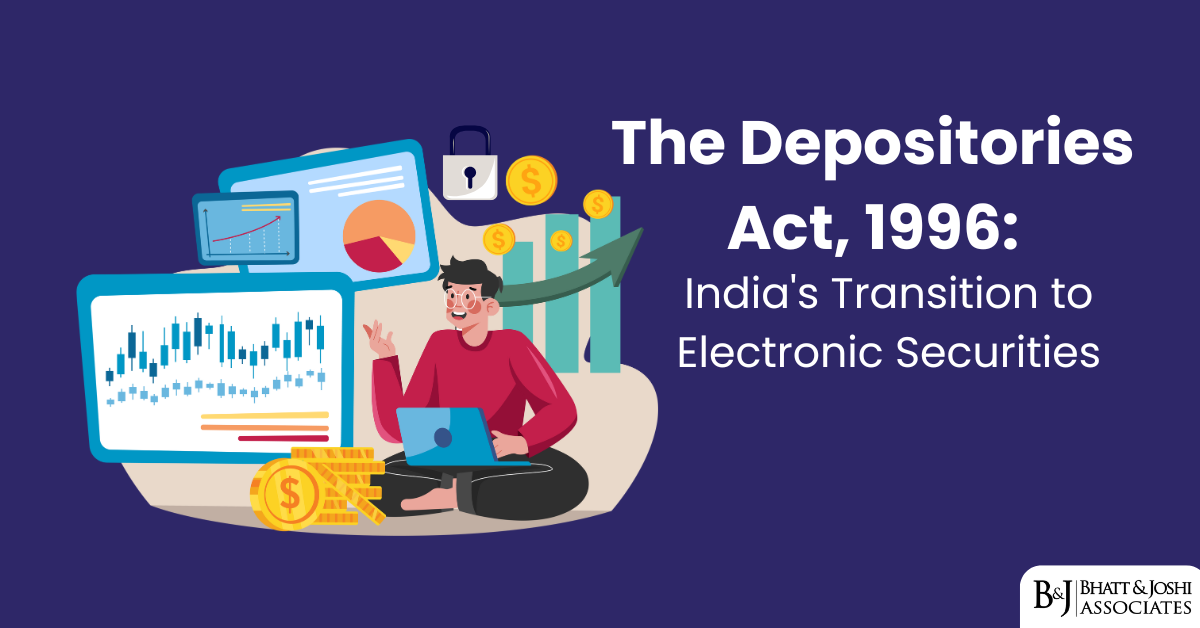Introduction
Before 1996, if you wanted to buy shares in India, you would get actual paper certificates. These certificates had to be kept safely, and whenever you sold shares, you had to physically deliver these papers to the buyer. This system caused many problems. Papers got damaged, lost, or even fake certificates were made. The process of transferring ownership was slow and sometimes took weeks to complete. The Depositories Act of 1996 changed all this by allowing shares to exist in electronic form. This meant no more paper certificates. Instead, all records of who owns which shares are kept safely in electronic databases managed by depositories. This big change made buying and selling shares much faster, safer, and easier for everyone. In this article, we will look at why this law was made, what it says, some important court cases related to it, and how it has helped Indian investors and the overall market.
Historical Context and Need for the Depositories Act
In the early 1990s, India’s stock markets were growing fast. Economic reforms had opened up new opportunities, and more people wanted to invest in shares. But the old paper-based system couldn’t handle this growth well. There were serious problems that needed to be fixed:
The “securities scam” of 1992, involving Harshad Mehta, showed how vulnerable the paper-based system was to fraud. In this scam, fake bank receipts were used to get money from banks, which showed how important it was to have better systems for keeping records.
Trading volumes were increasing, but physical settlement (actually handing over share certificates) was causing big delays. Sometimes it took more than a month to complete a transaction that should take just a few days.
Many investors lost money because of fake certificates, damaged papers, or delays in transfer. In some cases, companies refused to register transfers because signatures didn’t match exactly or because papers had minor damage.
The paperwork was becoming overwhelming. Stock exchanges were literally drowning in paper. The Bombay Stock Exchange alone was processing hundreds of thousands of physical certificates every day.
Looking at these problems, the government realized that India needed to move from paper certificates to electronic records, like many developed countries had already done. This led to the creation of the Depositories Act, 1996.
C.B. Bhave, who later became SEBI Chairman but at that time was working on setting up the National Securities Depository Limited (NSDL), explained the situation: “The paper-based system was like a ticking time bomb. The volumes were growing exponentially, but the infrastructure to handle physical certificates was collapsing under its own weight. Dematerialization was not just an option; it was an absolute necessity for the survival and growth of India’s capital markets.”
Key Provisions of the Depositories Act, 1996
Registration of Depositories (Section 3)
Section 3 of the Act sets the rules for who can become a depository. It states: “No depository shall act as a depository unless it obtains a certificate of registration from the Board (SEBI).”
To get this registration, a depository must be a company under the Companies Act and meet other requirements set by SEBI. Currently, India has two registered depositories: National Securities Depository Limited (NSDL) and Central Depository Services Limited (CDSL).
The Act gives SEBI the power to set conditions for registration and to cancel registration if a depository fails to follow the rules. This helps ensure that depositories operate in a safe and reliable way.
Rights and Obligations of Depositories (Section 5)
Section 5 defines what depositories can and must do. According to this section: “Subject to the provisions of this Act, the depositories shall register the transfer of securities in the name of the transferee and where the securities are held with the depository, it shall register the transfer of securities in the name of the beneficial owner.”
This means depositories must:
- Keep accurate records of all securities held in electronic form
- Process transfers quickly when shares are bought or sold
- Maintain confidentiality of information about investors
- Follow SEBI’s rules for how records should be kept
- Provide regular statements to investors about their holdings
The section also makes it clear that depositories can’t trade in securities themselves. They are only meant to keep records, not to buy and sell shares on their own account.
Dematerialization and Re-materialization (Sections 8-10)
Sections 8 to 10 cover the process of converting physical certificates into electronic form (dematerialization) and, if needed, converting them back to physical form (re-materialization).
Section 8 explains: “Every person subscribing to securities offered by an issuer shall have the option either to receive the security certificates or hold securities with a depository.”
This means investors can choose whether they want physical certificates or electronic records. However, for many types of trading, especially on stock exchanges, electronic form is now mandatory.
Section 9 explains how dematerialization works: “Any person who has entered into an agreement with a depository shall surrender the certificate of security for which he seeks to avail the services of a depository, to the issuer in such manner as may be specified in the bye-laws.”
Once the certificate is surrendered and verified, the issuer cancels the physical certificate and tells the depository to create an equivalent electronic record.
Section 10 covers the reverse process: “Any beneficial owner may, at any time, withdraw a security from a depository in such manner as may be specified in the bye-laws.”
In practice, very few investors ask for physical certificates nowadays because electronic form is much more convenient.
Depository Participants and Beneficial Owners (Sections 7-8)
An important feature of the depository system is that investors don’t deal directly with depositories. Instead, they open accounts with “depository participants” (DPs), which are like brokers or banks that provide access to the depository.
Section 7 states: “Any person may open an account with a depository for the purpose of dealing in securities.”
Section 8 introduces the concept of “beneficial ownership.” When shares are held in electronic form, the depository’s name appears in the company’s register as the holder, but the real owner (the investor) is called the “beneficial owner.”
The section clearly states: “Every person subscribing to securities offered by an issuer shall have the option either to receive the security certificates or hold securities with a depository.”
And more importantly: “Where a person opts to hold a security with a depository, the issuer shall intimate such depository the details of allotment of the security, and on receipt of such information, the depository shall enter in its records the name of the allottee as the beneficial owner of the security.”
This means that even though the depository’s name appears in official records, the rights of ownership (like receiving dividends or voting at meetings) belong to the investor.
Penalties for Violations (Sections 19A-19G)
The Act includes strict penalties for breaking its rules. For example:
Section 19A says that failing to follow any provision of the Act can result in a penalty of up to one crore rupees.
Section 19B covers penalties for failure to enter into agreements with clients properly, which can lead to a penalty of one lakh rupees per day.
Section 19F deals with penalties for failure to reconcile records, which can be up to one crore rupees.
These penalties show how seriously the law takes the proper functioning of the depository system, given its importance to the entire financial market.
Landmark Court Cases
Rakesh Kathotia v. SEBI (2007) SAT Appeal No. 117/2006
This case was about who has the rights of ownership when shares are held in a depository. Rakesh Kathotia had shares in his depository account, but there was a dispute about whether he had pledged these shares to someone else.
The Securities Appellate Tribunal (SAT) made an important ruling about beneficial ownership. It said: “The Depositories Act clearly establishes that the beneficial owner is the real owner of the securities even if they are held in the name of the depository in company records. All rights that would accrue to the holder of physical securities automatically accrue to the beneficial owner.”
This judgment confirmed that investors who hold shares in electronic form have exactly the same rights as those who hold physical certificates. It gave investors confidence in the new electronic system.
National Securities Depository Ltd. v. SEBI (2017) SAT Appeal No. 147/2016
This case dealt with the responsibilities of depositories for maintaining accurate records. SEBI had penalized NSDL for certain lapses in its systems. NSDL appealed to the SAT, arguing that it had followed all reasonable procedures.
The SAT upheld SEBI’s order and stated: “Depositories are the backbone of the securities market infrastructure. Their responsibility to maintain accurate records is absolute and cannot be diluted. Even minor lapses can have major consequences for market integrity.”
The tribunal further noted: “The Depositories Act imposes a high standard of care on depositories because they are entrusted with the crucial task of keeping electronic records that form the basis of ownership of securities worth trillions of rupees.”
This case established that depositories must maintain extremely high standards in their operations because of the critical role they play in the financial system.
Karvy Stock Broking v. SEBI (2020) SAT Appeal
This was a landmark case that highlighted the importance of proper segregation of client securities in the depository system. Karvy Stock Broking had allegedly misused client securities by pledging them for their own loans without client permission.
The case revealed a serious misuse of the depository system and led to major regulatory changes. SEBI took strong action against Karvy, and the SAT upheld most of these actions.
In its judgment, the SAT observed: “The Depositories Act and related regulations create a sacred trust between clients and their depository participants. Any breach of this trust strikes at the very foundation of market integrity. The proper segregation of client assets is non-negotiable.”
This case led to stronger regulations about how brokers can handle client securities and improved monitoring systems to prevent such misuse in the future.
Technological Transformation of Securities Holding
The Depositories Act 1996 enabled a complete transformation in how securities are held and traded in India. This transformation had several important aspects:
From Physical to Digital
The most obvious change was the shift from physical certificates to electronic records. This eliminated problems like fake certificates, loss or damage of papers, and signature mismatches during transfers.
A senior official from CDSL once shared: “Before dematerialization, the settlement department of stock exchanges looked like a paper factory. Mountains of share certificates had to be physically checked, sorted, and delivered. Today, millions of shares change hands with just a few keystrokes.”
Speed and Efficiency
In the paper-based system, settling a trade could take weeks because certificates had to be physically delivered, verified, and then registered by companies. Now, settlement happens in just T+2 days (trade date plus two working days).
In fact, from October 2023, India even moved to a T+1 settlement cycle for many securities, making it one of the fastest settlement systems in the world.
Cost Reduction
The cost of transacting in securities has fallen dramatically. There’s no need for stamp duty on transfers, no risk of loss during transit, and no storage costs for keeping physical certificates safe.
According to a study by the National Stock Exchange, the total cost of trading and settlement fell by more than 60% after dematerialization was widely adopted.
Increased Market Participation
The easier, faster, and safer electronic system encouraged more people to invest in the stock market. The number of demat accounts grew from just a few thousand in 1997 to over 100 million by 2023.
This increased participation has been particularly important for retail investors from smaller cities and towns, who earlier faced difficulties in dealing with physical certificates.
Investor Protection Measures under the Depositories Act, 1996
The Depositories Act 1996 included several features specifically designed to protect investors:
Account Statements and Information
Depositories and their participants must regularly provide statements to investors showing their holdings and all transactions. This transparency helps investors keep track of their investments.
Nomination Facility
The Act allows investors to nominate someone who would get their securities if something happens to them. This made inheritance much simpler compared to the complex legal process required for physical certificates.
Grievance Redressal
The Act requires depositories to have proper systems for handling investor complaints. Both NSDL and CDSL have established dedicated investor grievance cells to address problems quickly.
Insurance and Safeguards
Depositories maintain insurance covers and have created investor protection funds to compensate investors in case of defaults by depository participants.
Multiple Checks and Balances
The electronic system has multiple levels of verification and authentication to prevent unauthorized transfers. Investors receive SMS and email alerts for any transactions in their accounts, allowing them to detect any unauthorized activity immediately.
Comparative Analysis with Global Depository Practices
India’s depository system, while inspired by global models, has some unique features:
Competitive Model
Unlike many countries that have a single central depository, India chose to have multiple competing depositories (currently NSDL and CDSL). This competition has led to better services and lower fees for investors.
Integration with Banking System
India’s depository system is well integrated with the banking system. Most banks act as depository participants, allowing investors to manage their shares and bank accounts through a single institution.
Advanced Technological Features
India’s depositories implemented advanced features like online access, mobile apps, and electronic voting rights for shareholders quite early compared to many developed markets.
Cost Structure
The cost of maintaining a demat account in India is among the lowest in the world, making it accessible to small investors. This contrasts with some developed markets where custody fees can be significant.
Globally respected financial expert Dr. Ajay Shah noted: “India’s leapfrog into dematerialization in the 1990s was remarkable. While developed markets had evolved gradually from paper to electronic systems over decades, India made the transition in just a few years. And in some ways, the Indian system turned out to be more modern and efficient than many older systems in developed markets.”
Current Challenges and Future Developments for the Depository System
Despite its success, the depository system still faces some challenges:
Cybersecurity Concerns
As with any electronic system, cyber threats are a constant concern. Depositories continually need to upgrade their security systems to protect against hacking, unauthorized access, and other cyber risks.
Reaching Remote Areas
While urban India has widely adopted demat accounts, penetration in rural areas remains limited. Expanding access to these areas remains a challenge.
New Types of Securities
The system needs to evolve to handle new types of financial instruments like REITs (Real Estate Investment Trusts), InvITs (Infrastructure Investment Trusts), and potentially even digital assets in the future.
Cross-Border Investments
As Indian investors increasingly look at global markets and foreign investors come to India, better integration with international depository systems becomes important.
Looking ahead, depositories are working on several new initiatives:
- Using blockchain technology to further improve security and efficiency
- Enabling electronic holding of non-financial assets like academic certificates and property records
- Creating a unified platform for investors to view and manage all their financial assets in one place
- Developing systems for faster cross-border settlements
Conclusion: Impact and Future of the Depositories Act, 1996
The Depositories Act, 1996 marked a turning point in India’s financial markets. By enabling the shift from paper certificates to electronic records, it solved numerous problems that had plagued the market for decades. The result has been faster, safer, and more efficient trading, benefiting millions of investors.
The success of India’s depository system shows how well-designed regulations and technology can transform markets. From a paper-drowning system in the early 1990s, India now has one of the most modern securities holding systems in the world.
As we look to the future, the basic framework established by the Depositories Act 1996 continues to serve as the foundation for further innovations. The journey from paper to electronic was just the beginning. The next phase may well be from electronic to blockchain or other advanced technologies, but the principles of investor protection, efficiency, and transparency established by the Depositories Act will remain relevant.
In the words of a former SEBI chairman: “The Depositories Act didn’t just change how shares are held; it changed the entire investment culture of India. It made the stock market accessible to ordinary Indians in a way that was never possible before.”













